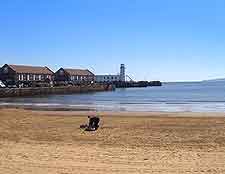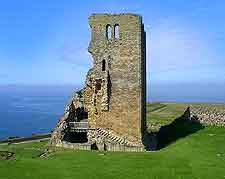Scarborough History Facts and Timeline
(Scarborough, North Yorkshire, England)

Scarborough has a rich history that is closely connected with its landscape. Made up of a headland and two wide bays, the town's strategic advantages led to its foundation as a stronghold. Later, its bays and beaches were to have an altogether different attraction.
The town dates back to Roman times. In 370 AD, a signal station was set up on the rocky headland where Scarborough Castle stands today. It operated as an early warning system to protect these North Yorkshire shores against the threat of Anglo-Saxon attack. When the Romans left Britain in 410 AD, the Anglo-Saxons moved in. So too did the Vikings in around 966 AD. In fact, Scarborough is first mentioned in the Viking sagas. It was known variously as Skarthborg and Skarthabork, derived from the nickname of one of its founders.
History in the Middle Ages
When the Normans arrived here following the Battle of Hastings, they quickly saw the town's potential as a stronghold. The headland was ideal for building a castle. Scarborough Castle was completed around 1130 by the Earl of Albermarle. It was eventually captured by King Henry II and by 1168, we know that it had become a royal castle.
In 1235, King Henry III gave the town a Royal Charter to hold an annual fair. The fair lives on to this day in a popular folk song. A medieval fishing town grew up beneath the castle. This medieval town was centred on Eastborough, Friargate, Tollergate and Longwestgate. During the centuries that followed, the castle was subject to many attacks and sieges.

16th to 18th Centuries
The 17th century saw Scarborough's decline as a strategic stronghold and its rise to fame as a holiday resort. Around 1620, spa water was discovered by a local gentlewoman, Elizabeth Farrow. She noticed that spring water emerged from the South Bay cliffs. Her claims as to the health-giving benefits of the water - namely to cure constipation, helped to make the spa a great success.
The growing popularity of spas throughout Britain at this time must also have helped further Scarborough's cause. In 1698, a sea wall was built, along with a cistern for the spa waters. When the spring was buried during a landslide in the early 18th century, it was replaced by a new, much grander spa building.
From 1785, the town of Scarborough also became a major ship building centre. As many as 15 ships were launched from here each year. A floating dock was built so that ships could also be brought for repair.
Victorian Times to the Present Day
By the time that Queen Victoria came to the throne, Scarborough had its own theatre, assembly rooms and libraries. The town even had its own Philosophical Society and museum. Much of the wealth brought to the town by its tourists was used to fund educational projects, including the building of schools and a Mechanics' Institute. The town's popularity was given an added boost with the arrival of the railway. From the 1850s, it could boast amusements and fun fairs, as well as beaches. One of Scarborough's most famous visitors at that time was Anne Bronte. She retired here from Haworth.
Although the town suffered damage during the First World War, the 20th century has been relatively uneventful. Today, Scarborough is a busy seaside resort. Its visitors come to enjoy not just its promenade and beaches, but also its interesting history.
 Scarborough has a rich history that is closely connected with its landscape. Made up of a headland and two wide bays, the town's strategic advantages led to its foundation as a stronghold. Later, its bays and beaches were to have an altogether different attraction.
Scarborough has a rich history that is closely connected with its landscape. Made up of a headland and two wide bays, the town's strategic advantages led to its foundation as a stronghold. Later, its bays and beaches were to have an altogether different attraction.